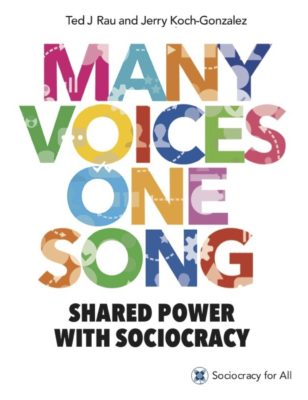 Won’t the prescriptive Norms in sociocracy and the Constitution in Holacracy impose the rule of law, which will quickly devolve into the rule of lawyers? The more arcane and opaque the law is, the more tyrannical that law becomes.
Won’t the prescriptive Norms in sociocracy and the Constitution in Holacracy impose the rule of law, which will quickly devolve into the rule of lawyers? The more arcane and opaque the law is, the more tyrannical that law becomes.
My response to this requires a distinction between laws and policies. Laws and policies are the same in that both govern future actions and decisions. Laws are made by governments to govern the actions of citizens of countries or parts of countries—cities, states, etc. They are enforced by various branches of the government—agencies, courts, etc.
Policies are made by organizationsThe Delibrative Democracy Consortium (DDC)u is an alliance o... to govern their own internal decision-making and operations. It is up to the organization and its members to enforce them. Unless the law specifically states otherwise, an organization’s policies must be within the requirements of the law.
A citizen can sue a government over unjust laws, or sue an organization over policies that are not in accordance with the law, but cannot sue an organization for not following its own internal policies as long as those policies are within the law.
Laws
The laws that lawyers’ address, are arbitrary and obscure. They are not necessarily based on what works and not regularly reviewed. Old laws, even 10 years old, can be based on out-dated conditions and don’t make sense, but they are still enforceable. For various reasons, they may not have made sense when they were adopted, or they made sense for one particular group but are applied universally.
The aim of a law is not always clear, and if not, the test is whether the law is still in force, not whether it has a purpose or achieves an aim .
Sociocracy & Holacracy: Testing What Works
The question about laws and lawyers was asked in the context of a comparison between sociocracy and Holacracy and the enforcement of their “laws.” This is where we get into the weeds.
The major influences on the sociocratic Norms are from engineering and physics, cybernetics, and mysticism. (Quaker faith on sitting together to reach consent). The major influences on Holacracy are sociocracy, computer software design, and mysticism. (Ken Wilber on ego vs higher purpose).
All the respective languages and applications—electrical engineering, computer software design, cybernetics, and mysticism— are based on testable processes. They change when new information is available. Sociocracy and Holacracy use these languages to define the processes used to achieve aims or purposes. Both have an easy test—if a practice isn’t working, the process either wasn’t understood or is being applied incorrectly.
Making Laws and Policies
The international sociocratic center has a process for certifying individuals and organizations but has no control over the use of the word sociocracy. The principles of the sociocratic circle-organization method have been adapted and modified in many ways in organizations that call themselves sociocratic. And are also used pristinely in organizations that don’t call themselves sociocratic. They are used by many management consultants who may call it by other names. As long as they do not imply that they are certified by the international organization, they are functioning lawfully.
It is not the same for the word Holacracy. Holacracy also has a certification program, but it is also a registered trademark. Individuals and organizations have to be certified or given approval to say they use Holacracy. Since trademarking is a law, the use of Holacracy without permission can bring in the lawyers and the case taken to court. The test is whether permission was given, not whether an organization is properly following the constitution. Here we are back to laws, lawyers, and judges. It is a violations of the law or isn’t it? Did the use happen or not? The question is not “did the use achieve a positive result?”
Some have suggested that this is the reason the Holacracy Constitution is so dense and written in legalese—so it can be used in litigation. Certainly a lawyer was involved because the language had to have been studied for years to be used so obscurely. An easier basis for legal action, however, is simply the use of the word in any way that might confuse Holacracy with other methods of governance or imply connections without permission.
The Tyranny of Laws
Only certification and trademarking are protected by law. Then disputes can be argued in court and the government enforce the decision. Lawyers will make the arguments.
When the aim is to govern organizations that are effective and harmonious, the law has no place, but policies do. Policies are agreements within organizations. Members of organizations work more effectively and harmoniously if they have expectations that are shared and understood, and based on what works to help them work effectively. Effectiveness and harmony require resilience, the ability to adapt to new situations, and full control over self-organization.
I think no one will argue that neither laws nor lawyers encourage self-organizationSelf-organization, sometimes called spontaneous order, is a ... More.
For extra credit:
The word holarchy was created by Arthur Koestler in , published in 1967, to describe a hierarchy of holons, self-organizing units that are both a part and a whole. There is no trademark on holarchy.
Categories: Decisions and Power, History and Philosophy

